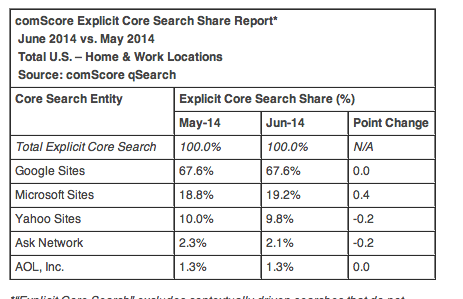Introduction: This post is primarily targeted to marketers in the US and other English-speaking countries. Those of you that hail from other locales may be more accustomed to thinking globally.
Prioritize Google vs Bing
In just about every country in the world Google is by far the dominant search engine by market share. Bing is still a great search engine with features like Facebook integration that even Google doesn’t have. However, after five years, Microsoft still has yet to gain significant market share against Google. Microsoft’s challenge might be less a product problem than it is a marketing problem. In blind ‘taste tests’ run by the SurveyMonkey Audience last year, there were a significant amount of users who chose Bing results over Google; nonetheless, Microsoft can’t seem to get the mass of users to start Binging instead of Googling.
Given this reality, most marketers allocate the majority of their organic marketing efforts to optimizing for Google, and when there is a conflict between optimizing for Google or Bing, it would make the most sense to prioritize for Google. Google has the largest market share, so it is just smart economics to go where the most revenue or users can be found.
The same logic of prioritizing optimization efforts should apply to all optimization efforts on your sites. Even the countries and languages you choose to target should consider where you will find the most users and revenue. Restricting your audience to just the United States or only English speakers could be as foolish as only optimizing for Yahoo or Bing.
Internet Population
While the Internet may have been invented in the United States, the US no longer has the greatest share of Internet users. In 1996, 66% of all Internet users in the world were based in the US. In 2014, US Internet users comprised less than 10% of the world’s 2.4 billion Internet users. The US is a distant #2 behind China’s 640 million Internet users — twice the number of actual people in the US! Additionally, China has very low Internet penetration at just 40%, which means there is still significant room for growth. India, also in the top five countries with the largest Internet populations, has one of the lowest Internet penetration rates in the world at just 19%. Given the sheer size of the Indian population and their current growth rates, it won’t be long before India surpasses the United States as well.
Internet Penetration
Not only is the world’s greatest concentration of Internet users not in the United States, the US isn’t even the most connected country with just about 86% of the population currently connected to the Internet. The US lags other English-speaking countries like the UK and Canada, where penetrations is close to 90 percent. There are even multiple countries around the world such as the Qatar, Iceland, the Netherlands and Finland with close to 100 percent penetration.
This means your website could transcend borders, but if it is only targeted to US customers, you are potentially neglecting 90 percent of the world.
You can immediately address the targeting by offering global shipping if you sell a physical product (when allowed by law) or creating more generic content if your website product is content. Focusing on the US user only is just like optimizing for Yahoo (for the sake of this analogy let’s pretend it has its own search algorithm!) and its 10 percent user base. Expand your marketing horizons beyond a small subset of users and open up your site’s audience to non-US users.
Global SEO
Now let’s say, your website is in English but isn’t entirely US focused. You might offer global shipping, but only have shipping instructions in English. Your spelling and references are generic enough that they make sense to anyone that reads and understands English. While English is the lingua franca of the entire world, you may be surprised to discover that as a first (primary) language, English is only the third most popular language behind Mandarin and Spanish. Just 6 percent of people in the entire world speak and read English natively.
Multilingual SEO
Luckily, some of the larger Internet population countries speak English, so having English only on your site still allows you to effectively target the 12 percent of the world’s Internet users that live in the US, Canada, United Kingdom, Australia, New Zealand and some smaller countries that count English as their official language. Since there are also people in the world that might understand English as a second language (English is the most popular language on the web), your reach might go up to about 20-25 percent. (This is a guess, but please share in the comments if you have a better way of calculating actual reach.) Continuing with the search engine analogy, targeting one quarter of the world’s Internet users is not even as effective as only optimizing for Bing’s algorithm.
According to Comscore’s latest search market penetration report, Bing and Yahoo combined have 29 percent of the search engine market share. It doesn’t make sense to prioritize search engine optimization efforts for Bing’s algorithm while potentially ignoring Google’s 62 percent market share and, with the same logic, it doesn’t make sense only to target English users and potentially ignore 75 percent of the world’s Internet users.
 screenshot 7-29-14
screenshot 7-29-14Expanding the targeting of your site outside of the US and to other languages doesn’t have to be complicated. It can be as simple as allowing global shipping and making phone support available during the daytime for other countries. For non-English traffic, just a few translated pages can go a long way to increasing your global traffic.
In a future post, I will dive deeper into how to best internationalize a site, but in the meantime just apply the same logic to country/language targeting as you would for all other optimization efforts. Follow the money.
Featured Image: Moyan Brenn via Flickr Creative Commons




